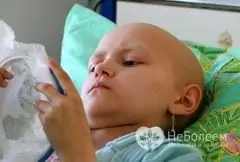- Author Rachel Wainwright [email protected].
- Public 2023-12-15 07:39.
- Last modified 2025-11-02 20:14.
Pediatric oncology

All over the world, there is a steady increase in the number of oncological diseases and their earlier onset, as well as the number of tumors in children. Pediatric oncology is a branch of medicine that makes a rather successful attempt to counter this sad trend.
Despite the constant hard work in this direction, the mechanism of the occurrence of a malignant tumor is still unclear. Currently, more and more researchers are inclined to believe that the leading role in this is played by a violation of the immune system in combination with a genetic predisposition. In many ways, these findings are due to pediatric oncology, the study of the development of the tumor process in childhood. This is confirmed by the leading experts of the Israeli Cancer Center, and as you know, cancer treatment in Israel is one of the most successful in the world.
The course of childhood cancer has some differences. So, the malignant process in childhood is more aggressive, develops rapidly, manifests itself in vivid symptoms, in contrast to adults, in whom a long-term illness proceeds with scanty symptoms or generally asymptomatic. However, this quality in pediatric oncology is more likely to be positive, since it allows diagnosing the disease earlier and starting treatment earlier. At the same time, despite its incomplete development, the child's immune system copes better with the disease. Thus, the difference between pediatric oncology and adult oncology is that tumor diseases in children are more severe, but amenable to therapy better than in adults.
The most common childhood cancers are acute leukemia (blood cancer) and brain tumors. These diseases, according to world medical statistics, rank first and second among all childhood tumors, significantly ahead of all other tumor pathology. Representatives of pediatric oncology in developed countries note with concern the growth of these types of diseases in children, which is mainly associated with environmental pollution, and not only chemical waste, but also ionizing radiation, which, alas, accompany us more and more in everyday life.

Carcinogenic additives to industrially manufactured food are also dangerous. These three types of pollution are the main mutagenic factors that can cause the degeneration of a healthy cell into a tumor one. Given that the first peak of both blood cancer and brain cancer occurs in early childhood (from 1 to 5 years), it is believed that the main damaging effect of mutagenic factors occurs during the period of intrauterine development of the child. This means that measures for the prevention of childhood cancers must begin with measures to protect the health of the pregnant woman.
Found a mistake in the text? Select it and press Ctrl + Enter.






